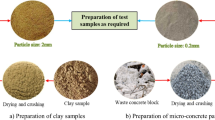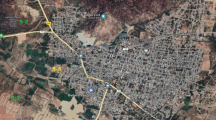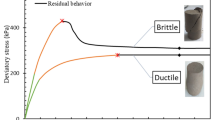Abstract
Compacted clay layers are known as earth dams’ most common impermeable layer. However, owing to the specific nature of clay and Atterberg limits, an increase in age damage, these layers by cracking them. Despite this, the crack-healing property of clay is the main factor in closing external cracks. In this regard, in this study, a new method is used to evaluate clays’ self-healing characteristic by pinhole tests with the variation of the Plasticity Index (PI). For this purpose, three soil samples from the Vanyar Dam located in Iran were treated to obtain the PI between 7 and 26 by adding different percentages of bentonite (i.e., 5%, 10%, 15%, and 20%) and the impact of bentonite percentage increase was investigated on self-healing property and outflow rate of clay soil. Subsequent to geotechnical tests, the obtained results showed that adding bentonite to the soil samples with optimum water content and 2% below it, decreases soil dispersion and makes it non-dispersive. In addition, the self-healing phenomenon was visible and predictable with the increase of bentonite in natural soil; as for the sample with 20% bentonite, this phenomenon was observed from an early age due to high PI and the potential for high inflation. Also, the sample with 20% bentonite and a moisture content of 2% less than the optimum showed the most reduction in the outflow (38%) when compared with the natural soil sample. Therefore, it can be concluded that the PI variation (between 7 and 26) can cause non-dispersivity of clay and increase the self-healing ability.










Similar content being viewed by others
References
Aitchison G, Wood C (1965) Some interactions of compaction, permeability, and post-construction deflocculation affecting the probability of piping failure in small earth dams. Proc 6th ICSMFE 2:442–446
Bendahmane F, Marot D, Alexis A (2008) Experimental parametric study of suffusion and backward erosion. J Geotech Geoenviron Eng 134:57–67
Eigenbrod K (2003) Self-healing in fractured fine-grained soils. Can Geotech J 40:435–449
Fell R, Wan CF, Cyganiewicz J, Foster M (2003) Time for development of internal erosion and piping in embankment dams. J Geotech Geoenviron Eng 129:307–314
Foster M, Fell R, Spannagle M (2000a) A method for assessing the relative likelihood of failure of embankment dams by piping. Can Geotech J 37:1025–1061
Foster M, Fell R, Spannagle M (2000b) The statistics of embankment dam failures and accidents. Can Geotech J 37:1000–1024
Honjo Y, Veneziano D (1989) Improved filter criterion for cohesionless soils. J Geotech Eng 115:75–94
Kakuturu S, Reddi LN (2006a) Evaluation of the parameters influencing self-healing in earth dams. J Geotech Geoenviron Eng 132:879–889
Kakuturu S, Reddi LN (2006b) Mechanistic model for self-healing of core cracks in earth dams. J Geotech Geoenviron Eng 132:890–901
Moffat R, Fannin RJ, Garner SJ (2011) Spatial and temporal progression of internal erosion in cohesionless soil. Can Geotech J 48:399–412
Roushangar K, Homayounfar F (2019) Prediction characteristics of free and submerged hydraulic jumps on horizontal and sloping beds using SVM method. KSCE J Civ Eng 23:4696–4709
Seed HB, Woodward J, Lundgren R (1962) Prediction of swelling potential for compacted clays. J Soil Mech Found Div 88:53–88
Sherard J, Decker R (1977) Summary—evaluation of symposium on dispersive clays. In: Dispersive Clays, Related Piping, and Erosion in Geotechnical Projects. ASTM International
Sherard JL, Decker RS, Ryker NL (1972) Piping in earth dams of dispersive clay. Proceedings, Specialty Conference on Performance of Earth and Earth-Supported Structures. ASCE, 1:584-626
Wang J-J, Zhang H-P, Zhang L, Liang Y (2013) Experimental study on self-healing of crack in clay seepage barrier. Eng Geol 159:31–35
Author information
Authors and Affiliations
Corresponding author
Additional information
Responsible Editor: Zeynal Abiddin Erguler
Rights and permissions
About this article
Cite this article
Roushangar, K., Alami, M.T. & Houshyar, Y. Experimental investigation of bentonite impact on self-healing of clay soils. Arab J Geosci 13, 1122 (2020). https://doi.org/10.1007/s12517-020-06131-x
Received:
Accepted:
Published:
DOI: https://doi.org/10.1007/s12517-020-06131-x




